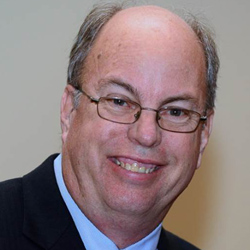Jeffrey Ardell, Founding Director of the UCLA Neurocardiology Research Program of Excellence, is a fellow of the American Heart Association and has been one of the principal investigators in the field of neurocardiology for the last three decades. Ardell will be a keynote speaker at NeuroCAS, a collaborative workshop that will explore the future challenges of neurotechnology. IEEE Pulse recently spoke with him about the role neuromodulation will play in cardiac disease intervention.
IEEE Pulse: What are some of the challenges in using neuromodulation for treating disease?

Jeffrey Ardell: Recently, there has been a realization that there is substantial unmet need in understanding the precise elements of the structure function organization for neural control of organs and how best to leverage that information. We also lack full understanding of how that structural and functional organization changes with pathology and how we can intervene to prevent pathology progression. Programs such as SPARC (Stimulating Peripheral Activity to Alleviate Conditions), supported by the NIH, aim to meet that need.
In relation to heart disease, what we have tried to understand is how the different levels of the autonomic neural control systems associated with the heart interact with each other; how these systems adapt with pathology; and more importantly, if we intervene at any one point, how exactly does that intervention translate into what goes on both upstream and downstream from those intervention points. It’s really through understanding the ways we are impacting that neural hierarchy that we can develop effective neuromodulation techniques.
For example, when I work with companies, one of my main objectives is for them to understand that it’s all about the interface that you use, it’s where you place that interface, and it’s also about understanding what happens when you start intervening with that interface in terms of how the nervous system functions. The nervous system is set up to maintain homeostasis, and it actively defends that. If you go in with a neuromodulation device, you’re essentially trying to make it move to a place that it doesn’t necessarily want to go, and you have to learn to do that intelligently.
IEEE Pulse: In what ways do cardiac neuromodulation techniques offer more targeted treatment of heart disease?
JA: Heart disease by its very nature is usually associated with an increase in activity in the sympathetic nervous system, and a decrease in activity on the parasympathetic nervous system. What happens with the onset of cardiac disease is that you get a hyperdyanamic response within the sympathetic, which is trying to maintain function, and the parasympathetic restraining influences go away. In the short term, this helps you maintain cardiac function, but in the long term it contributes to the pathology.
One targeted strategy we’ve pioneered is essentially damping down the sympathetic nervous system. We’ve done that using a technique called spinal cord stimulation where we put devices over the dorsal columns of the spinal cord and then apply an electrical current in order to diminish reflexes. Another way to achieve that dampening effect is through vagal nerve stimulation. Here the parasympathetic projections are activated, which stabilizes the heart and reduces the sympathetic outflow. We also have technologies where we can block specific nerves using various types of blocking currents—either high frequency AC or DC currents—opening possibilities for moving the nerve signals up or down depending on what we want to do in terms of their activity.
Cardiac neuromodulation is actually moving forward on multiple fronts right now. There are reasonable studies using vagal nerve stimulation which are still underway, there are approaches which are using baroreceptor stimulation that are well underway, and there is still some support for the concept of using spinal cord stimulation for treating heart disease. There is also some degree of rational for using renal ablation to treat disease, and studies are progressing with selectively getting rid of certain afferent populations of the heart. A large part of disease processes, at least in cardiovascular, are the result of abnormal afferent signaling and if we can go in and change that afferent signaling we can actually have a substantial impact on the progression of disease.
With heart disease, the pattern of care is still very much surgical or pharmacological and we are just now on the cusp of starting to employ neuromodulation devices. However, traditional approaches to treatment such as surgery and pharmacological interventions pretty much have ossified in terms of their efficacy, so if we are going to make substantial progress in the future we need to learn how to leverage the nervous system to treat cardiac disease and to modulate nervous system activity. We are really on the cutting edge of how you go about doing this and the things we are working on now will become standard of care within the next 5-10 years. Essentially, we’ve had to have a paradigm shift in how we look at these diseases and how we treat them.
IEEE Pulse: Has there been success of neuromodulation devices in clinical trials?
JA: There are a number of neuromodulation devices in clinical trials right now; some of these clinical trials have done well, some haven’t. In fact, most of them haven’t done well. Why have some failed? In my experience, the primary reason tests have been failing is because of an incomplete understanding of the nervous system they’re trying to intervene against. If you don’t understand the structure function organization of what’s causing the problem, then as a result, the approaches designed don’t essentially take advantage of that system.
In addition, others have failed because they’re stimulating in ways that just don’t make sense. When you talk about stimulations you’ve got to consider frequencies, pulse widths, amplitudes, duty cycle, etc., and all of those are going to have an influence on your outcome. Ultimately, you need to understand what that influence is if you’re going to actually have an effective therapy. Many times it seems that companies rush to proof of concept without doing the relevant background research to understand what they’re attempting to do, and if you just close your eyes and throw a dart at something, chances are you’re not going to hit it.
Again, it really comes down to the fact that you need to understand where you intervene and how you intervene in order to achieve effective therapy. If you’ve done this process incorrectly, you actually have a chance of doing harm to the patient. That’s why it’s very important to better understand the parameters of the system you are working with on the front end, otherwise you are likely wasting your time when attempting to apply that incomplete solution.
IEEE Pulse: Where do you see growth potential and opportunity in the field of neuromodulation?
JA: One of the interesting growth areas is that we are moving toward an approach where we form multidisciplinary teams with the primary objective of understanding structure function of the nervous system. These teams include everyone from neurophysiologists to electrophysiologists to molecular biologists to people who are good at bioengineering and informatics. For example, our team at UCLA has funded grants across 18 different institutions, with people hailing from a variety of disciplines, all focused on understanding neural control of the heart in normal and pathological conditions. When you find a limitation and an unmet need, the model now is that you go and find the best people to work with you to overcome those limitations, which is very different from the model that existed in science for the last 40-50 years where most of us functioned as individual researchers with limited inter-institution collaborations.
By having different people looking at the same basic approach from multiple ways in a coordinated fashion, we’ve seen understanding across the field increase dramatically just in the last five years. The field is basically exploding with new information in all areas. Bioengineers and engineers in particular are best placed to have an impact if they’re working with people who understand the system they are designing for. You don’t do this type of work in a vacuum.



